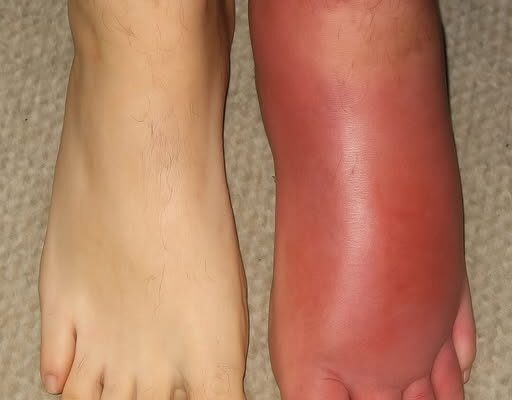Sudden redness, swelling, or warmth in one leg is more than just a discomfort—it can be a warning sign of an underlying medical problem that requires immediate attention. While not every case points to a life-threatening emergency, the risks are serious enough that such symptoms should never be brushed aside.
Deep Vein Thrombosis (DVT)
One of the most concerning causes is deep vein thrombosis, or DVT. This condition occurs when a blood clot develops in a deep vein, most often in the lower leg or thigh. DVT can block normal circulation, causing the leg to swell, turn red, and feel warm or tender. The real danger arises if the clot breaks loose and travels to the lungs, creating a pulmonary embolism. This can cause sudden chest pain, shortness of breath, or even collapse—and it can be fatal without urgent treatment.
Cellulitis
Another possibility is cellulitis, a bacterial infection of the skin and underlying tissue. Unlike minor skin irritations, cellulitis spreads quickly and can become serious if left untreated. It typically causes redness, heat, swelling, and pain in the affected area, sometimes accompanied by fever or chills. Antibiotics are the primary treatment, and delaying care allows the infection to progress, increasing the risk of complications.
Superficial Thrombophlebitis
In some cases, swelling and tenderness in the leg may be due to superficial thrombophlebitis. Here, a blood clot forms in a vein close to the skin rather than deep inside the leg. While generally less dangerous than DVT, it can still be painful and may signal underlying circulation issues that require evaluation.
Chronic Venous Insufficiency
Chronic venous insufficiency is another condition to consider. When the valves in leg veins weaken or fail, blood pools instead of flowing efficiently back to the heart. Over time, this can cause persistent swelling, redness, aching, or even skin discoloration and ulcers. Although not an emergency in every case, untreated venous insufficiency can significantly affect quality of life and lead to chronic complications.
Other Causes
Several other conditions can mimic these symptoms. Gout or arthritis may cause joint swelling and redness, sometimes confused with infection or clotting disorders. Injuries such as sprains or fractures may also produce warmth and swelling. Lymphedema, a buildup of lymphatic fluid often linked to surgery or radiation therapy, can cause chronic swelling and skin changes. While these conditions vary in severity, they all benefit from medical assessment to ensure proper care.
When to Seek Help
What matters most is not ignoring sudden or unexplained symptoms. Medical attention should be sought urgently if:
-
Swelling appears suddenly and is painful
-
The leg feels unusually warm, red, or tender
-
Symptoms are accompanied by fever or chills
-
There is chest pain, dizziness, or shortness of breath (possible signs of a pulmonary embolism)
Because the causes range from treatable infections to potentially fatal clots, professional evaluation is essential. Quick action can prevent complications, ensure the right treatment, and in some cases, save lives.
Bottom Line
Redness, warmth, and swelling in one leg should always be taken seriously. From DVT and cellulitis to venous problems or injuries, these symptoms are your body’s signal that something is wrong. When in doubt, it is far better to seek urgent medical care than to risk delay.
Disclaimer: This information is for educational purposes only and should not be taken as medical advice. If you notice sudden leg swelling or related symptoms, consult a qualified healthcare professional immediately.



